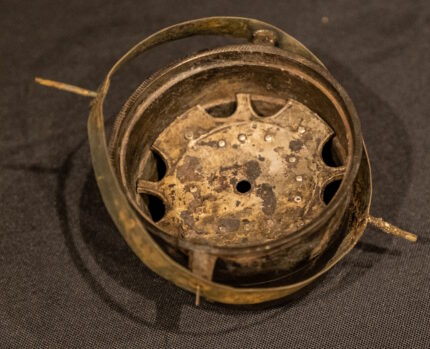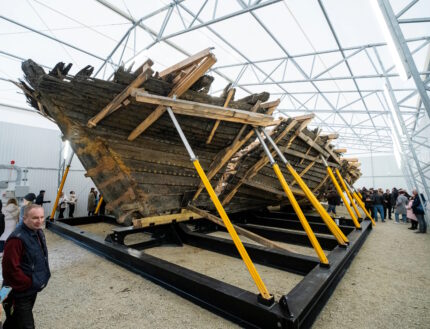 One of the artifacts recovered from the wreck of the medieval ship unearthed near the Old Town Harbor of Tallinn, Estonia, in 2022, is Europe’s oldest dry compass still in working order.
One of the artifacts recovered from the wreck of the medieval ship unearthed near the Old Town Harbor of Tallinn, Estonia, in 2022, is Europe’s oldest dry compass still in working order.
 The cog was excavated from its location on Lootsi Street and transported to the Estonian Maritime Museum in four pieces. Archaeologists of the Estonian Maritime Museum and experts in ship conservation from Finland have been cleaning and conserving the cog in a purpose-built hall where visitors can see the work in progress.
The cog was excavated from its location on Lootsi Street and transported to the Estonian Maritime Museum in four pieces. Archaeologists of the Estonian Maritime Museum and experts in ship conservation from Finland have been cleaning and conserving the cog in a purpose-built hall where visitors can see the work in progress.
 The excavation and conservation process uncovered a number of finds in excellent condition, including leather shoes, wooden spoons and tools, preserved by the waterlogged mud of the harbor. The shoes were well-worn and repaired, so not cargo intended for sale. This suggests the ship was sunk in an accident and everyone who could escape did so, leaving behind their belongings. The compass and the well-preserved remains of two rats who apparently did not desert the sinking ship were the most surprising finds.
The excavation and conservation process uncovered a number of finds in excellent condition, including leather shoes, wooden spoons and tools, preserved by the waterlogged mud of the harbor. The shoes were well-worn and repaired, so not cargo intended for sale. This suggests the ship was sunk in an accident and everyone who could escape did so, leaving behind their belongings. The compass and the well-preserved remains of two rats who apparently did not desert the sinking ship were the most surprising finds.
[Archaeologist Priit Lätti of the Estonian Maritime Museum] aid that Estonia’s medieval ships really stand out among other similar finds because they are not empty. Medieval ships found in Germany and the Netherlands are mostly empty, the researcher said.
“Ours are full of finds, and the finds are wall to wall, giving us clues about everything from eating habits on board to clothing to navigational equipment,” he said.
Too many typos!
This does not mention how old the compass is….
…”Medieval ships in Germany and the Netherlands”…
…to a certain extent, were back then the ones that went to and fro Tallinn in Estonia. It was King Valdemar II of Denmark, who had successfully converted the Estonians.
In fact, ‘Taani’ (=”Denmark”) and ‘linnus’ (=”castle”) gave “Tallinn” its name: The city grew around Valdemar’s castle. However, Tallinn received Lübeck city rights in 1248…
…”Lübeck city rights” was probably, what also (in Scotland) William Wallace -a.k.a. the “Highlander”- was having in mind, when in 1297AD Andy Murray and him wrote a letter to the City of Lübeck, where it is still kept.
Instead, the English took him to London, where he was half-hanged, drawn and quartered:
—-
“Andreas de Morauia et Willelmus Wallensis, duces exercitus regni Scotie et Communitas eiusdem regni, providis viris et discretis ac amicis dilectis, majoribus et communibus de Lubek et de Hamburg, salutem et sincerae dilectionis semper incrementum.
Nobis per fide dignos mercatores dicti regni Scotiae est intimatum, quod vos vestri gratia, in omnibus caufis et negociis, nos et ipsos mercatores tangentibus, consulentes, auxiliantes et favorabiles estis, licet nostra non praecesserint merita, et ideo magis vobis tenemur ad grates cum digna remuneracione, ad quae vobis volumus obligari; rogantes vos, quatinus praeconizari facere velitis inter mercatores vestros, quod securum accessum ad omnes portus regni Scotiae possint habere cum mercandiis suis, quia regnum Scotiae, Deo regraciato, ab Anglorum potestate bello est recuperatum. VALETE.
Datum apud Badsingtonam in Scotia, undecisimo die Octobris, anno Graciae, millesimo ducentesimo nonagesimo septimo. Rogamus vos insuper ut negotia Johannis Burnet, et Johannis Frere, mercatorum nostrorum, promoveri dignemini, prout nos negotia mercatorum vestrorum promovere velitis. -VALETE. Datum ut prius.”
—-